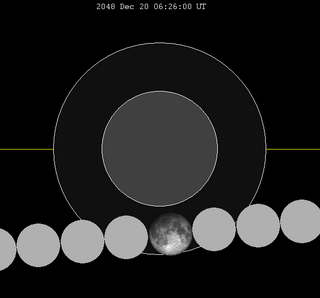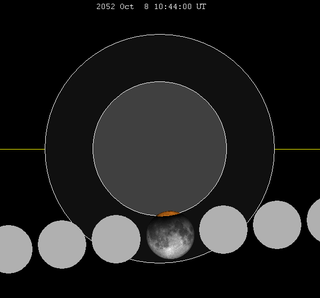| Partial eclipse | |||||||||||||
 | |||||||||||||
| Date | 22 January 2046 | ||||||||||||
|---|---|---|---|---|---|---|---|---|---|---|---|---|---|
| Gamma | 0.9885 | ||||||||||||
| Magnitude | 0.0532 [1] | ||||||||||||
| Saros cycle | 115 (59 of 72 [2] ) | ||||||||||||
| Partiality | 50 minutes 23 seconds | ||||||||||||
| Penumbral | 250 minutes 1 second | ||||||||||||
| |||||||||||||
A partial lunar eclipse will take place on January 22, 2046.
| Partial eclipse | |||||||||||||
 | |||||||||||||
| Date | 22 January 2046 | ||||||||||||
|---|---|---|---|---|---|---|---|---|---|---|---|---|---|
| Gamma | 0.9885 | ||||||||||||
| Magnitude | 0.0532 [1] | ||||||||||||
| Saros cycle | 115 (59 of 72 [2] ) | ||||||||||||
| Partiality | 50 minutes 23 seconds | ||||||||||||
| Penumbral | 250 minutes 1 second | ||||||||||||
| |||||||||||||
A partial lunar eclipse will take place on January 22, 2046.
| Descending node | Ascending node | |||||
|---|---|---|---|---|---|---|
| Saros | Date Viewing | Type Chart | Saros | Date Viewing | Type Chart | |
| 115 | 2046 Jan 22  | Partial | 120 | 2046 Jul 18  | Partial | |
| 125 | 2047 Jan 12  | Total | 130 | 2047 Jul 07  | Total | |
| 135 | 2048 Jan 01  | Total | 140 | 2048 Jun 26  | Partial | |
| 145 | 2048 Dec 20  | Penumbral | 150 | 2049 Jun 15  | Penumbral | |
| Last set | 2045 Aug 27 | Last set | 2045 Mar 03 | |||
| Next set | 2049 Nov 09 | Next set | 2049 May 17 | |||
A lunar eclipse will be preceded and followed by solar eclipses by 9 years and 5.5 days (a half saros). [3] This lunar eclipse is related to two partial solar eclipses of Solar Saros 122.
| January 16, 2037 | January 27, 2055 |
|---|---|
 |  |

A total lunar eclipse will take place on July 7, 2047. It will last 1 hour 40 minutes and 49 seconds and will plunge the full Moon into deep darkness, as it passes right through the centre of the Earth's umbral shadow. While the visual effect of a total eclipse is variable, the Moon may be stained a deep orange or red colour at maximum eclipse. This will be a great spectacle for everyone who sees it. The partial eclipse will last for 3 hours and 39 minutes in total.
A penumbral lunar eclipse took place at the Moon's descending node of the orbit on Tuesday, August 26, 1980, the last of three penumbral lunar eclipses in 1980 with a penumbral magnitude of 0.70891. This subtle penumbral eclipse may have been visible to a skilled observer at maximum eclipse. 70.891% of the Moon's disc was partially shaded by the Earth, which caused a gentle shadow gradient across its disc at maximum; the eclipse as a whole lasted 3 hours, 34 minutes and 26 seconds.

A penumbral lunar eclipse will take place on June 15, 2049.

A total lunar eclipse will take place on January 1, 2048. It will be the first recorded lunar eclipse to be visible on New Year's Day for nearly all of Earth's timezones. The next such eclipse will occur in 2094.

A penumbral lunar eclipse will take place on March 3, 2045.

A total lunar eclipse will take place on September 19, 2043.

A total lunar eclipse will take place on September 7, 2044. It will be the first total eclipse in Lunar Saros 138.

A total lunar eclipse will take place on March 13, 2044.

A total lunar eclipse will take place on March 25, 2043.

A penumbral lunar eclipse will take place on April 5, 2042.

A partial lunar eclipse will take place on July 18, 2046.

A penumbral lunar eclipse will take place on December 20, 2048.

A partial lunar eclipse will take place on June 26, 2048. The Moon will be strikingly shadowed in this deep partial eclipse lasting 2 hours and 39 minutes, with 63.88% of the Moon in darkness at maximum.

A total lunar eclipse will take place on January 12, 2047.

A penumbral lunar eclipse will take place on May 17, 2049.

A penumbral lunar eclipse will take place on November 9, 2049.

A total lunar eclipse will take place on April 26, 2051.

A penumbral lunar eclipse will take place on Sunday, April 14, 2052.

A total lunar eclipse will take place on October 30, 2050.

A partial lunar eclipse will take place on October 8, 2052.